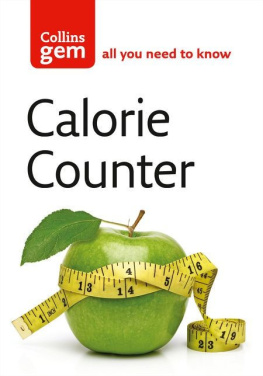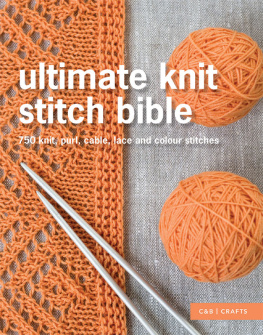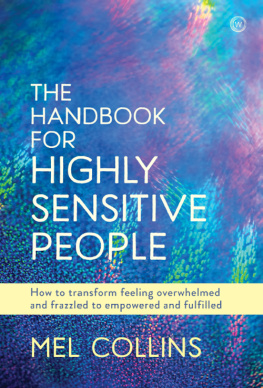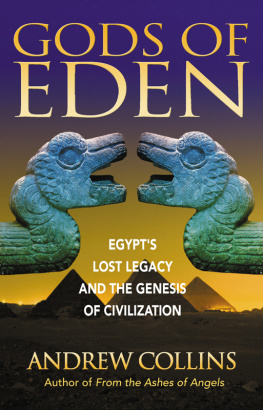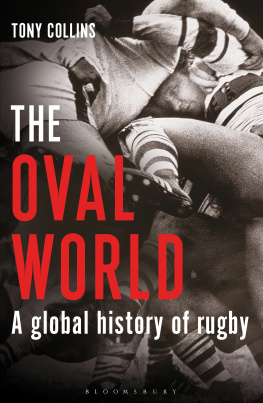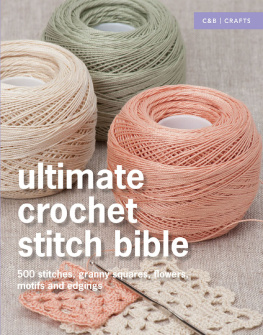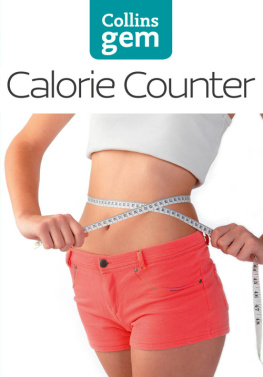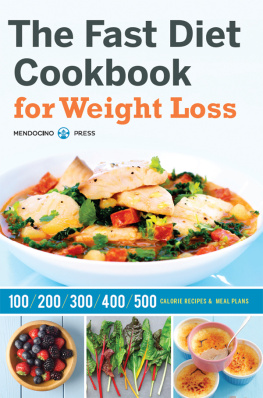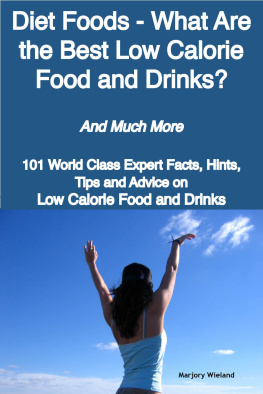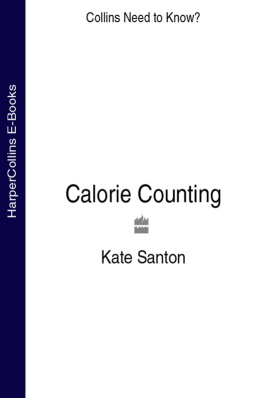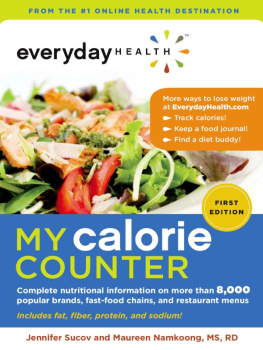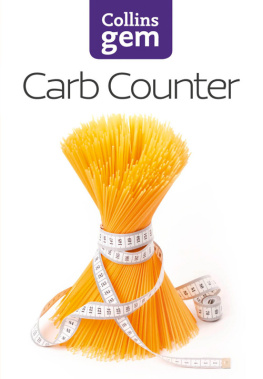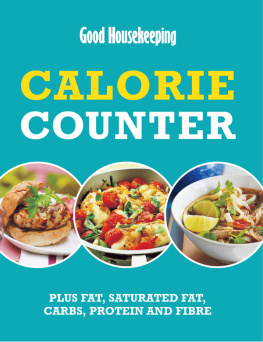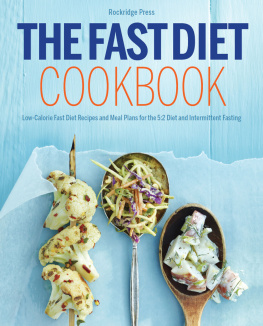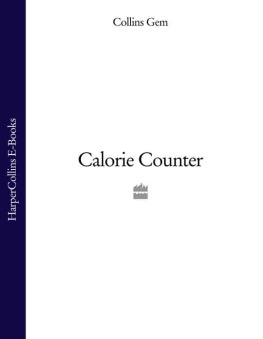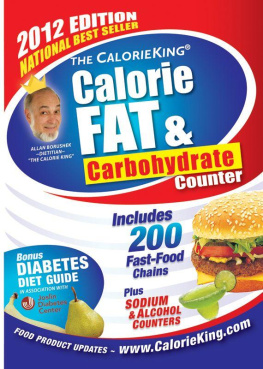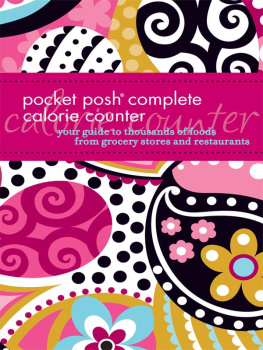Calorie Counter

Table of Contents
The Collins Gem Calorie Counter is one of the most successful guides available for weight-watchers. In this new edition, youll find a new selection of foods, reflecting the range of foods now available. The Calorie Counter doesnt just list the calorie content of each food; it gives its nutritional composition as well, and we have also updated this data. Calorie content is given in either 100g measurements, or per item where it seems logical to do so; an emphasis has been placed on providing the most accurate information in the most user-friendly format.
The book contains:
It has long been known that the healthiest and most effective way to lose weight and maintain that loss is to combine a healthy, calorie-controlled diet with exercise. We hope that this guide will help you to plan the best way to restrict your calorie intake.
www.bbc.co.uk/health/healthy_living/your _weight/ (excellent site with medical advice, tips, eating well, fitness and useful contacts)
www.nhs.uk/livewell/loseweight (excellent basic advice including tips and encouraging real stories)
www.eatwell.gov.uk (useful, practical information on healthy diet issues and on matters such as food labelling)
www.netdoctor.co.uk/health_advice/facts/ loseweight.htm (practical general site with plan outlines)
www.bdaweightwise.com (excellent site run by British Dietetic Association; can put you in touch with a dietitian)
www.nutrition.org.uk (good, sensible advice based on research; can put you in touch with a nutritionist)
www.weightconcern.com (addresses physical and psychological needs of overweight people)
www.weightlossresources.co.uk (a wide range of information)
www.caloriecounter.co.uk (a general guide including useful special topics)
www.ibodz.com (exercise site with advice on exercise and weight loss)
www.recipezaar.com (US site with calorie-counted recipes from around the world)
Calorie-counting has sometimes had a bad press, dismissed as being out of date and boring. Some diets have even gone so far as to announce that calories dont count.
One of the reasons for the poor reputation of old-fashioned calorie counting is that there was an emphasis on obsessive calculating, on using low-calorie processed food and ready meals, and on sticking to the assigned calorie limits no matter what. This combination of factors made calorie counting almost impossible to stick to and proved to be impractical in the long term. There was no emphasis on enjoying a healthy diet you could eat your allocated calories in chocolate if you wished and an almost complete lack of flexibility. Other, newer, apparently more user-friendly ways of losing weight seemed much more interesting but, in the long term, most of these have proved to be every bit as unsustainable.
Calories, however, always do count. They are just a measure of energy. Take in more calories than your body uses and the weight goes on as the excess is stored as fat; use more calories than you take in and the weight comes off as the body uses the energy it has stored. Reducing calorie intake is how all effective diets work, and theres no magic solution that involves anything else.
To make sure that you can reduce your calorie intake reasonably accurately, you will have to count the calories in the food you eat and the liquids you drink. That doesnt have to be depressing; nor does it mean that you will have to walk around for the rest of your life with a notebook under your arm, this book in one hand and a calculator in the other. Successful dieters become calorie aware, able to spot the low-calorie, nutritionally sound option at a glance, and also have a mental library of quick calorie shortcuts (youll find some at the end of this Introduction). Small changes can make a significant difference; for instance, weaning yourself off three cappuccinos a day and swapping to black coffee instead could save hundreds of calories. This book will help you to learn the values for all your favourites and serve as a quick reference in which to look up new foods. But successful calorie counting isnt just about adding up the figures and keeping them to a certain limit; its about being healthy as well. Then it really can be the start of a process of sustainable change.
Whats a calorie?
Calories are a simple measurement of available energy: not fat, just energy. When food is metabolised it produces heat, and that energy is measured in kilocalories (kCal). A single scientific calorie is a very small measurement of energy, and scientists use the 1000-calorie measure the kilocalorie instead. Outside scientific circles, kilocalories have become known as calories and in this book, as in most other contexts, calorie is used instead of kilocalorie.
All food contains calories and all calories are the same regardless of their origin, apart from exceptional circumstances. The real difference comes in the nutritional benefits food has and not in the calories it contains; energy is not the bodys only requirement, which is why a healthy diet is critical. Like all living things, the human body requires chemical building blocks, the nutrients which enable it to grow, develop normally, maintain itself, repair damage, manufacture hormones and perform many other functions. An apple and a boiled sweet may well make the same number of calories of energy available to the body about 50 but they wont bring the same health benefits. Calorie counting does bring freedom as you are not tied to any particular diet plan, but freedom brings responsibility and you need to ensure that you are as healthy as possible.
Fad diets
Diets suggesting you omit an entire category of food, eat a lot of any particular food or any alleged miracle food should ring alarm bells. So should any diets that promise rapid weight loss or that dont advise you to increase exercise especially in the maintenance phase as well as cut your food intake.
Assessing weight
Its important to be realistic when looking at what you want to weigh and at how long it will take to get there, and the first thing to do is gather some information. Measure your height and weight before you start but do so in metric units metres and kilograms as this makes assumptions less likely.
WAIST MEASUREMENTS
Check this first. Doctors take waist measurements seriously because people who carry excess fat round the waist are in the highestrisk category for high blood pressure, heart disease and strokes. If your waist measurement rises above 94cm (for men) and 80cm (for women) you are putting your health at risk. If its above 102cm for men and above 88cm for women, your health is at serious risk and you should start a weight-loss programme as soon as possible. A related risk indicator is the waist-to-hip ratio. The waist is measured at the narrowest point and that figure is divided by the hip measurement at the widest point. A high figure is more than 1.0 in men and 0.85 in women; a healthy value is anything below these.

